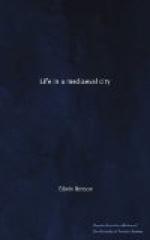“Like to the old Vice ...... Who with dagger of lath In his rage and his wrath, Cries, Ah, ah! to the devil.”
and in Henry V.:
“...
this roaring devil i’ the old play
that every one may pare his
nails with a wooden dagger.”
Stands for spectators were erected by private enterprise for profit in many places in the city. The general assembly, preparatory to the beginning of the performances {original had “performanes"}, took place on Pageant Green, now called Toft Green (which lies behind that side of Micklegate which is opposite Holy Trinity). The first performances were made at the gates of Holy Trinity Priory (on the west side of the river); there were four performances in Micklegate (a street near the Priory); four in Coney Street (the main street on the east side of the river)—and likewise performances in other parts of the city. The last three performances took place at the gates of the Minster; in Low Petergate, and in Pavement, which was one of the city market squares.
When Richard III. came to York in 1483, part of his entertainment consisted of performances of pageants.
The only other public dramatic entertainments were crude, coarse, popular plays, done by strolling players. A mediaeval crowd at fair time was entertained by mountebanks, tumblers, and similar rough makers of unrefined mirth.
The Corporation had a band of minstrels in its service.
Of physical games archery was the most practised. This was the national physical exercise, one which had helped the English soldiers to gain a great reputation for themselves, as at Agincourt (1415). At York the “butts,” where men practised archery, were outside the city walls.
G. CLASSES
Class divisions were well marked. They appeared in manners, in dress, and in occupation.
Fashions varied considerably as the century progressed. There were close-fitting dresses and loose ones, small head-dresses like the caul (a jewelled net to bind in the hair) and high and broad erections that went to the other extreme. Men now wore their hair long; later they had it close-cropped. Perhaps the most wonderful fashion was that which men followed in wearing hose of different colours. With all the vagaries of fashion the most striking feature of dress was the use of rich and a manifold variety of colours. Excepting the case of the dress of the religious, which was generally of a sombre hue, colour characterised men’s clothes as much as it did the dresses of women. The doublet was the coat of the time. Sleeves were generally big. Long and pointed shoes were characteristic, but it was the cloak that proved so effective a piece of dress, the cloak that has such scenic possibilities, that can so nicely express character. There were only few kinds of personal ornament. The most usual were brooches, belts, chains, and pendants, and especially finger-rings, of which the signet ring was a popular form.




